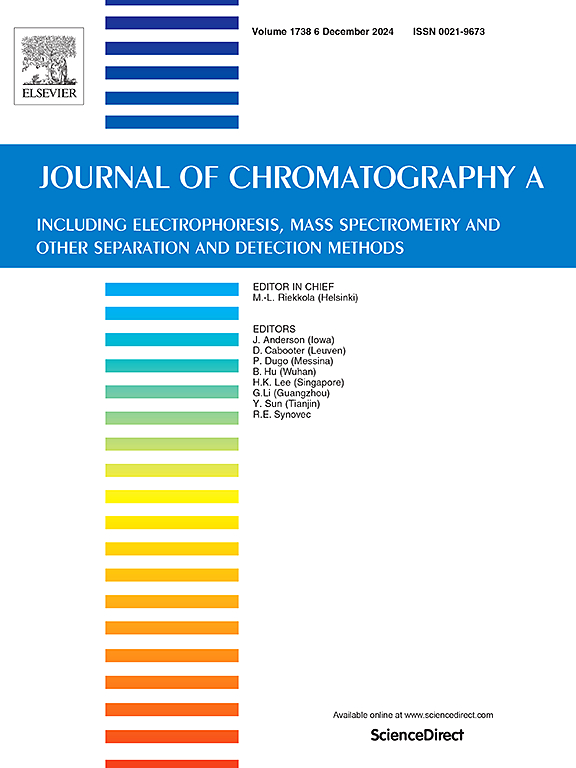用胶束电动色谱法研究人载脂蛋白与氧化1-棕榈酰-2-花生四烯酰- n-甘油-3-磷酸胆碱的结合产物
IF 3.8
2区 化学
Q1 BIOCHEMICAL RESEARCH METHODS
引用次数: 0
摘要
建立了胶束电动色谱法(MEKC)研究人载脂蛋白(Apos)与氧化1-棕榈酰-2-花生四烯酰基-sn -甘油-3-磷酸胆碱(ox-PAPC)结合产物。最佳MEKC分离缓冲液由10 mM磷酸钠、50 mM胆盐(50%胆酸钠和50%脱氧胆酸钠)、30% (v/v)1-丙醇和70% (v/v)水组成,pH为7.4。最佳的MEKC样品缓冲液由70% (v/v) PBS缓冲液和30% (v/v) MeOH组成。选择分离电压为20 kV,毛细管温度为25℃。ox-PAPC产品的MEKC谱显示出良好的分离性和重复性。载子蛋白及其结合产物的MEKC谱也表现出良好的重复性。本方法在0.00~ 6.00 mg/mL范围内呈线性,相关系数为0.9984。检测限(LOD)为0.29 mg/mL。定量限(LOQ)为0.98 mg/mL。研究了几种重要的人类载脂蛋白(载脂蛋白A-I、A-II、C-I、C-II、C-III和E)与天然PAPC、ox-PAPC产物的结合反应。结合反应的Apos和ox-PAPC产物的浓度已被检查。选择的最佳结合缓冲液为70% (v/v) PBS缓冲液和30% (v/v) MeOH。结合反应在37℃下进行3小时。结果表明,ox-PAPC产物与载脂蛋白A-I、A-II、C-I和E的结合比n-PAPC更强。然而,ox-PAPC产物和n-PAPC都没有与载脂蛋白C-II和C-III强烈结合。结果提示载脂蛋白A-I、A-II、C-I和E具有促炎特性,并暗示了导致HDL颗粒功能失调的分子机制之一。本研究也证明了用MEKC研究人载脂蛋白与ox-PAPC产物结合反应的可行性。本文章由计算机程序翻译,如有差异,请以英文原文为准。
Investigating the binding products between human apolipoproteins and oxidized 1-palmitoyl-2-arachidonyl-sn-glycerol-3-phosphocholine by micellar electrokinetic chromatography
A micellar electrokinetic chromatography (MEKC) method has been developed to investigate the binding products between human apolipoproteins (Apos) and oxidized 1-palmitoyl-2-arachidonoyl-sn‑glycero-3-phosphocholine (ox-PAPC) products. The optimal MEKC separation buffer was composed of a solution mixture of 10 mM sodium phosphate, 50 mM bile salts (50 % sodium cholate and 50 % sodium deoxycholate), 30 % (v/v)1-propanol and 70 % (v/v) water, pH 7.4. The optimal MEKC sample buffer was composed of 70 % (v/v) PBS buffer and 30 % (v/v) MeOH. The selected separation voltage was 20 kV, and the capillary temperature was 25℃. The MEKC profiles of ox-PAPC products showed good separations and repeatability. The MEKC profiles of apos and their binding products also showed good repeatability.
For the analysis of native PAPC (n-PAPC), the method is linear in the range of 0.00–6.00 mg/mL with a correlation coefficient 0.9984. The concentration limit of detection (LOD) is 0.29 mg/mL. The concentration limit of quantitation (LOQ) is 0.98 mg/mL.
The binding reactions between several important human apolipoproteins (Apos A-I, A-II, C-I, C-II, C-III and E) and native PAPC, ox-PAPC products have been investigated. The concentrations of Apos and ox-PAPC products for binding reactions have been examined. The optimal binding buffer selected was 70 % (v/v) PBS buffer and 30 % (v/v) MeOH. The binding reaction was performed at 37 ℃ for 3 hr.
The results indicated that ox-PAPC products bound to Apos A-I, A-II, C-I, and E more strongly than n-PAPC. However, both ox-PAPC products and n-PAPC did not bind to Apos C-II and C-III strongly. The results suggested pro-inflammatory properties of Apos A-I, A-II, C-I, and E, and implied one of the molecular mechanisms resulting in dysfunctional HDL particles. This study also demonstrated the feasibility of investigating the binding reactions between human apolipoproteins and ox-PAPC products by MEKC.
求助全文
通过发布文献求助,成功后即可免费获取论文全文。
去求助
来源期刊

Journal of Chromatography A
化学-分析化学
CiteScore
7.90
自引率
14.60%
发文量
742
审稿时长
45 days
期刊介绍:
The Journal of Chromatography A provides a forum for the publication of original research and critical reviews on all aspects of fundamental and applied separation science. The scope of the journal includes chromatography and related techniques, electromigration techniques (e.g. electrophoresis, electrochromatography), hyphenated and other multi-dimensional techniques, sample preparation, and detection methods such as mass spectrometry. Contributions consist mainly of research papers dealing with the theory of separation methods, instrumental developments and analytical and preparative applications of general interest.
 求助内容:
求助内容: 应助结果提醒方式:
应助结果提醒方式:


